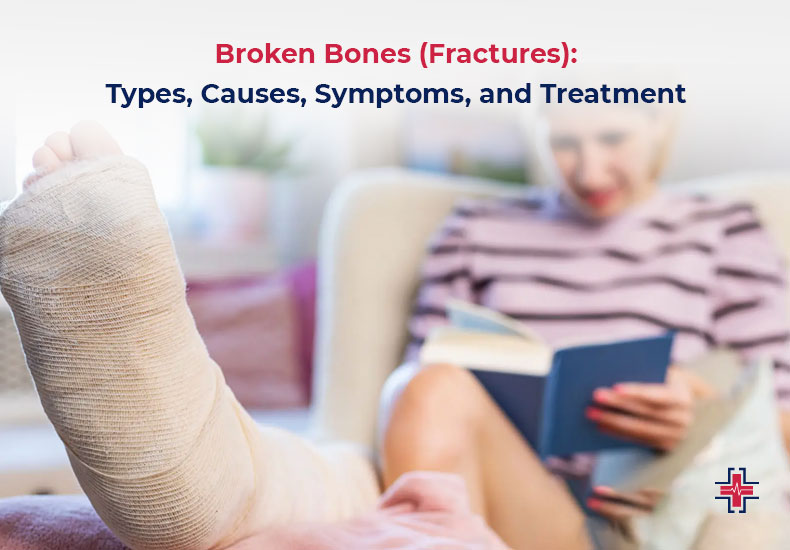A crack or break in a bone is called a bone fracture. High-force impacts or stresses are typically the cause of bone fractures. It is possible for individuals suffering from osteoporosis or bone cancer to sustain a minimally significant fracture.
A pathological fracture arises from a disease that causes the bones to deteriorate. This article describes in depth the types of broken bones, their underlying causes, and the therapies.
What Is a Broken Bone?
A complete or partial disruption in the continuity of bone tissue is called a broken bone. Bone fractures can happen to any part of the body.
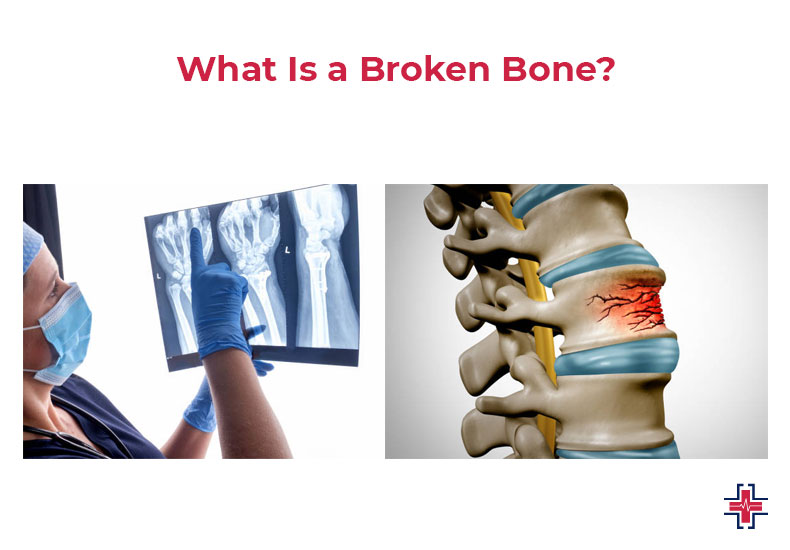
There exist multiple mechanisms by which a bone might break. A closed fracture, for instance, is a break in the bone without any skin tearing or damage to the surrounding tissue. A complex fracture, on the other hand, harms surrounding tissue and breaks through the skin. Because of the increased risk of infection, compound fractures are typically more dangerous than simple fractures.
Who Faces Broken Bone Issue?
Bone fractures can affect anyone. Usually, causes of broken bones are traumas like car accidents or injuries during sports. It is difficult to know when somebody will break the bone. If your bones are weak by osteoporosis you’re more likely to experience a fracture.
Because osteoporosis weakens bones, fractures that occur suddenly and unexpectedly are more likely to occur. Many people don’t become aware that they have osteoporosis until after it breaks a bone. Usually, there aren’t any overt signs.
Individuals who are born with a feminine gender assignment and those who are over 50 years old are more susceptible to osteoporosis. See your physician about scheduling a bone density test, which can identify osteoporosis early on and prevent fractures.
10 Common Types of Broken Bones
The type of broken bones can vary from open to closed, stable to displaced, partial to complete.
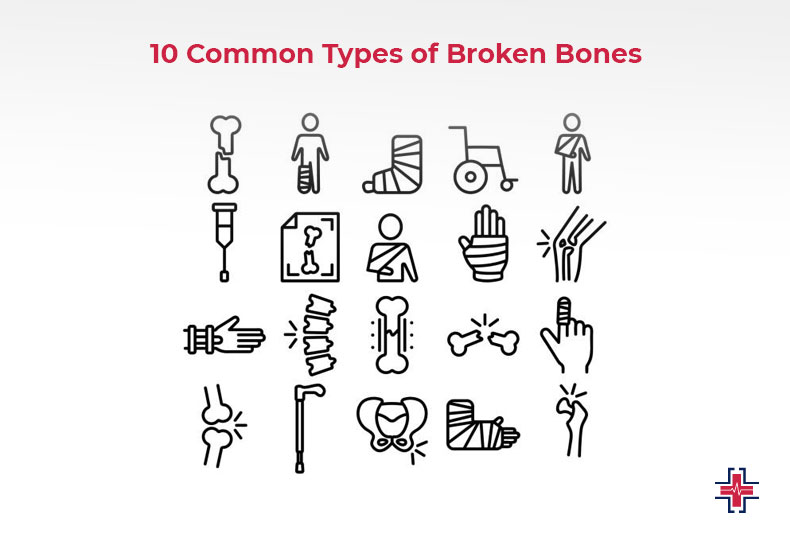
Transverse Fracture
Transverse fractures are breaks that are in a straight line across the bone. This type of fracture may be caused by traumatic events like falls or automobile accidents.
Spiral Fracture
This type of fracture, as its name implies, spirals around the bone. Long bones in the body, primarily the tibia, fibula, or femur in the legs, can sustain spiral fractures. But they can also develop in the arms’ long bones. Twisting injuries received in sports, during a physical attack, or in an accident can result in spiral fractures.
Compression Fracture
A compression fracture occurs when a bone is crushed. The fractured bone will appear flatter and wider than it did before the trauma. The most common type of fracture in the spine is compression, which can lead to the collapse of your vertebrae. Compression fractures are most commonly caused by osteoporosis, a kind of bone loss.
Greenstick Fracture
This type of partial fracture primarily affects young people. The bone cracks and flexes, but it does not split into two parts. Since their bones are softer and more flexible, children are more susceptible to suffering this kind of fracture.
Impacted Fracture
When the fractured ends of the bone are forced together, it results in an impacted fracture. The force of the injury that resulted in the fracture is pressing the fragments together.
Oblique Fracture
When a break occurs across the bone diagonally, it is called an oblique fracture. The most common type of fracture for long bones is this one. A fall or other trauma might cause a sharp impact to strike at an angle, which can result in oblique fractures.
Avulsion Fracture
When a tendon or ligament tears a piece of bone off the bone, it results in an avulsion fracture. Children are more likely than adults to suffer from these kinds of bone fractures. Ligaments in children can occasionally pull so forcefully that a growth plate fractures.
Segmental Fracture
A “floating” section of bone remains in between the two fractures in the same bone. Long bones, including those in the legs, are typically the site of these fractures. This kind of fracture could result in problems or take longer to heal.
Stress Fracture
Hairline fractures are another name for stress fractures. With standard X-rays, this kind of fracture can be challenging to diagnose since it resembles a crack. Running is one of the repetitive activities that can lead to stress fractures.
Comminuted Fracture
A fracture where the bone breaks into three or more fragments is known as a comminuted fracture. At the fracture site, there are also pieces of bone. These kinds of bone fractures happen following a high-impact trauma, like a car crash.
What Are the Causes of Broken Bones
Healthy bones are extremely resilient and can withstand surprisingly powerful impacts. However, under enough force, they may crack or break.
Physical trauma, overuse, and health conditions that weaken the bones, such as osteoporosis, are the leading causes of bone fractures. Other factors can also increase an individual’s risk of sustaining fractures.
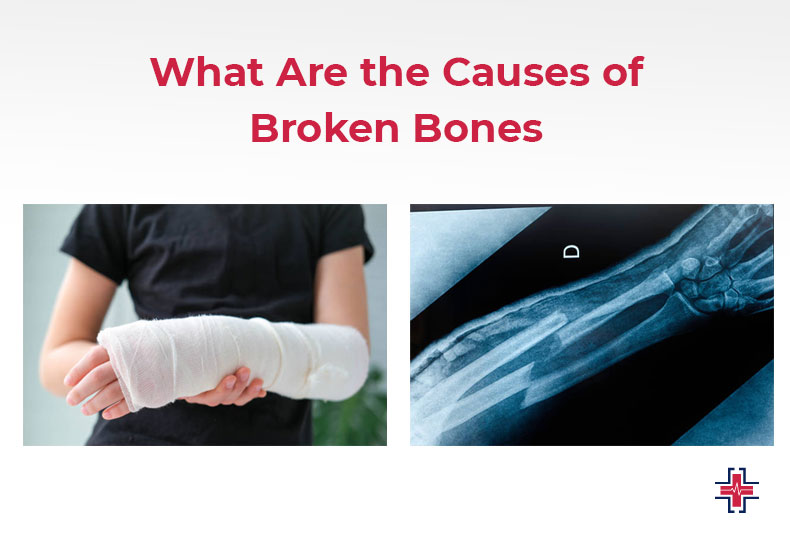
A person’s bones will typically weaken with age, which increases the risk of them breaking. As a person ages, the likelihood of their developing a condition that weakens the bones is also greater.
A bone fracture can occasionally occur without any trauma. Stress fractures can result from repetitive activities like jogging or sports. Similarly, overuse syndrome in your hands and arms can result from repeatedly performing the same action for an extended length of time. You have an increased risk of developing a stress fracture if you play an instrument or use your hands in the same manner every day at work.
What Are the Symptoms of Broken Bones
Symptoms of a fracture vary depending on its location, a person’s age and general health, and the severity of the injury.

However, people with a bone fracture will typically experience some of the following:
- Pain
- Swelling
- Bruising
- Discolored skin around the affected area
- Protrusion of the affected area at an unusual angle
- Inability to put weight on the injured area
- Inability to move the affected area
- A grating sensation in the affected bone or joint
- Bleeding if it is an open fracture
How to Diagnose Broken Bones
Your healthcare professional will use imaging studies and a physical examination to identify a bone fracture. If you are admitted to the emergency room following a trauma, this may occasionally be done there.
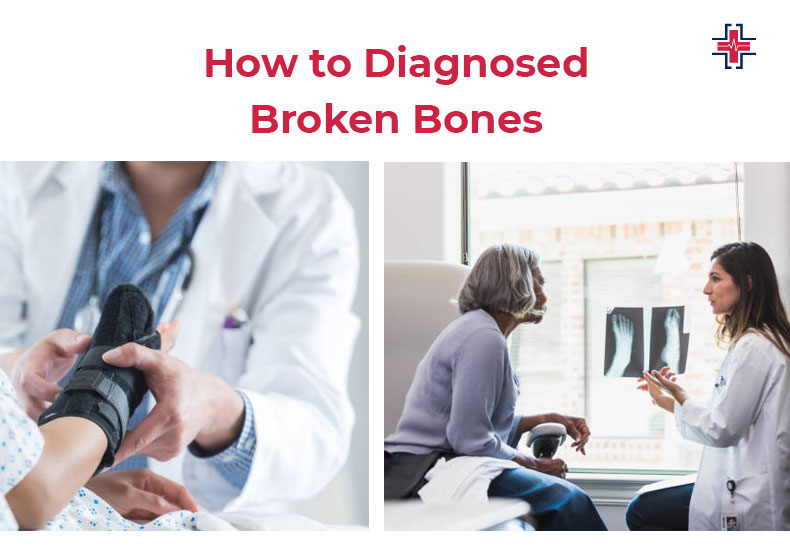
If you’re brought to the emergency room, a group of medical professionals will stabilize you and treat your wounds according to severity, particularly if any of them are potentially fatal. You will require imaging testing to confirm any fractures after you’ve been stabilized.
You’ll need at least one of a few imaging tests to take pictures of your fracture:
- X-rays: An X-ray will confirm any fractures, and show how damaged your bones are.
- Magnetic Resonance Imaging (MRI): Your provider might use an MRI to get a complete picture of the damage to your bones and the area around them. An MRI will show tissue like cartilage and ligaments around your bones too.
- CT scan: A CT scan will give your provider or surgeon a more detailed picture of your bones and the surrounding tissue than an X-ray.
- Bone scan: Healthcare providers use a bone scan to find fractures that don’t show up on an X-ray. This scan takes longer usually two visits four hours apart but it can help find some fractures.
What Treatment Do We Use to Treat Broken Bones
How your fracture is treated depends on which type it is, what caused it and how damaged your bones are.
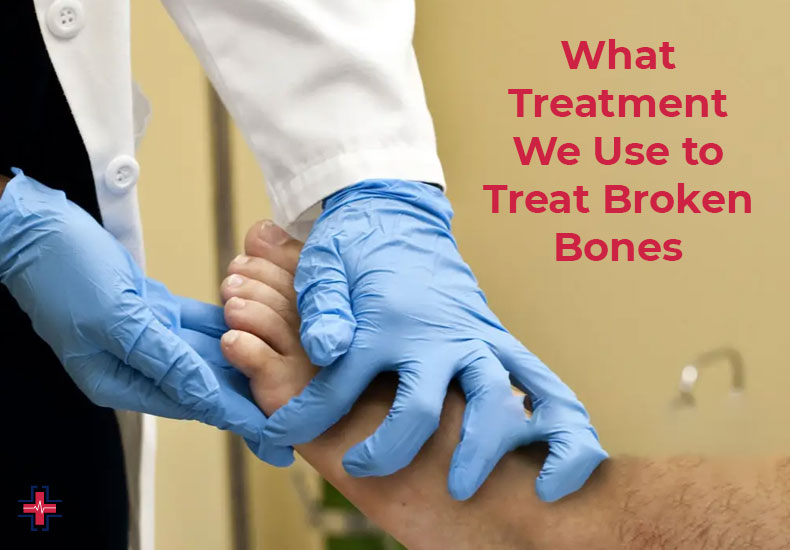
Immobilization
You may only require a splint or cast if your fracture is minor and your bones have not moved significantly out of place. The typical duration of splinting is three to five weeks. You’ll probably need a cast for a longer period of six to eight weeks, if necessary. You’ll probably need more X-rays in both situations to ensure that your bones are healing properly.
Broken Bones Surgery
Surgery is necessary for certain bone fractures. There are a few methods your surgeon may employ, depending on the kind of fracture you have and the extent of the bone damage.
External Fixation
Perhaps you require an external fixing. To link the screws to a brace or bracket around the bone outside of your body, your surgeon will drill holes in your bone on either side of the internal fracture. Usually, this is a stopgap measure to stabilize your fracture and allow it to heal before receiving an internal fixation.
Internal Fixation
Your bones will be securely placed once your surgeon realigns them to their proper alignment, allowing them to mend and grow back together. Typically, they carry out an internal fixation, in which your surgeon places small metal bits into your bone to stabilize it while it heals. To allow your bone to mend completely, you will need to minimize how much you use that area of your body.
Techniques for internal fixation consist of
- Rods: A rod that runs from top to bottom and is put into the middle of your bone.
- Plates and screws: To keep the parts together in situ, metal plates are screwed into your bone.
- Pins and wires: Too-small bone fragments are secured in place by pins and wires. Usually, they are utilized in conjunction with either rods or plates.
Some people have these implants in them permanently. It may require more procedures to eliminate them.
Arthroplasty
Should you break a joint (e.g., your knee, elbow, or shoulder), you may require an arthroplasty (joint replacement). The injured joint will be removed by your surgeon and replaced with an artificial joint. The prosthesis, or prosthetic joint, may be made of heavy-duty plastic, ceramic, or metal. The replacement joint will have the same appearance and motion as your original joint.
Bone Grafting
If your fracture is very dislocated or if your bone isn’t mending back together as it should, you may require bone grafting. To repair your broken bone, the surgeon will introduce more bone tissue. Following that, an internal fixation is typically performed to hold the fragments together while your bone grows back. There are several sources for bone grafts:
- Internally from another location within your body, typically the upper part of your hip bone.
- An outside contributor.
- A synthetic substitute component.
You will immobilize your bone following surgery. Before you can begin using it the way you did before your fracture, you’ll need to wear some combination of a sling, brace, cast, or brace.
Closed Reduction
A closed reduction is necessary to fix (realign) more severe breaks in your bones. Your healthcare professional will physically push and pull your body from the outside to realign the fractured bones inside of you during this non-surgical technique. One of the following will be given to you to keep you from experiencing discomfort during the procedure:
- To make the region around your fracture numb, apply a local anesthetic.
- Sedatives to help you unwind overall.
- During the procedure, you will be put to sleep using a general anesthetic.
Your healthcare practitioner will place you in a cast or splint following the closed reduction.
Broken Bones Vs Sprain
Sprains and bone fractures are frequent sports injuries. One or more of your bones have shattered if you have a bone fracture. A bone cannot be sprained. A sprain occurs when a ligament is damaged or stretched. A bone fracture and a ligament sprain can occur simultaneously from an injury, particularly if the joint in question is damaged, such as the elbow or knee.
Broken Bones Vs Bruise
Both painful injuries bone fractures and bone bruises are brought on by a significant force striking your body, most commonly from a fall, auto accident, or sports injury. The degree of bone damage makes a difference.
As living tissue, your bones are susceptible to bruises in many of the same ways that your skin is. Although the injury is similar, bruising a bone requires far more effort than bruising skin. Your bones can bleed without breaking if an object strikes them hard enough. A bone bruise is caused by blood getting trapped beneath your bone’s surface following an accident.
When something strikes your bone hard enough to shatter it in at least one location in addition to causing damage, you have a bone fracture. Compared to bone bruising, fractures are more serious injuries and might recover more slowly.
See your doctor or the emergency room as soon as you can if you feel pain on or near a bone after a trauma. It’s critical to have an immediate examination of your bone, regardless of the type of injury you have.
Broken Bones Vs Fractures
Broken bones and bone fractures are the same injury with the same meanings. They may be used interchangeably. Since a fracture is the medical word for a broken bone, once they have made the diagnosis, your healthcare practitioner will most likely refer to your fractured bone as a particular kind of fracture.
How Long Can Broken Bones Go Untreated
The patient will require surgery to fix the fracture if treatment is not received for it within four weeks. If the wound is not healed completely, it may turn necrotic. Many times, spinal fractures go unnoticed. There will be grounds for a claim if the damage was dangerous and left the patient paralyzed.
Broken Bones X-ray How They Work?
A bone or a tumor, which is denser than the soft tissues, allows few of the X-rays to pass through and appears white on the X-ray. At a break in a bone, the X-ray beam passes through the broken area and appears as a dark line in the white bone.
An X-ray is produced when a negatively charged electrode is heated by electricity and electrons are released, thereby producing energy. That energy is directed toward a metal plate, or anode, at high velocity and an X-ray is produced when the energy collides with the atoms in the metal plate.
Takeaway
Even though broken bones are common injuries, they’re still scary to experience. If you break a bone, go to the Urgent Care Mesquite. Most people who break a bone make full recoveries and can return to their pre-injury routine and activities with no long-term impacts.
Don’t rush your recovery. Giving your body the time it needs to get better can be frustrating, but it’s the best way to make sure you don’t re-injure your bone while it heals.
